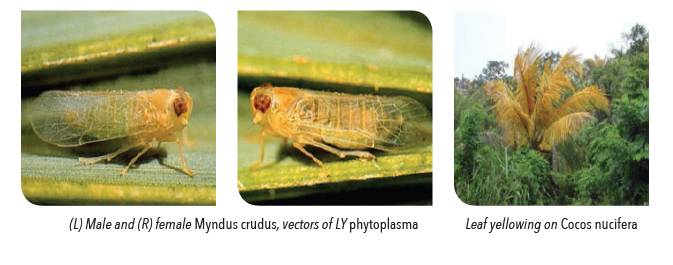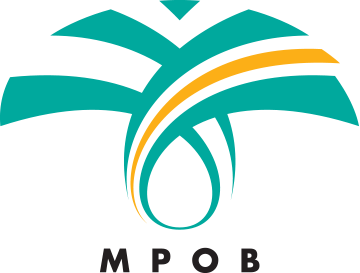General Information

Myndus crudus is a vector of the lethal yellowing (LY) phytoplasmas (Candidatus Phytoplasma palmae). Lethal yellowing is highly destructive palm disease affecting at least 30 palm species (including Elaeis guineensis and Cocos nucifera).
LY involves a prolonged a symptomless phase. External symptoms (e.g. premature nutfall and inflourescence necrosis) begin to show only after 112 to 262 days from infection. As the disease progresses, the emerging influrescences exhibit necrosis (usually at the tips of flower spikelets) and may be totally discoloured. Subsequently, all male flowers die and the palm does not set fruits. Leaf yellowing starts after inflourescence necrosis. Leaf discolouration occurs rapidly, starting with the lowermost leaves and upwards to the crown. Yellowed leaves turn brown, dry up and die. In some cases, leaf yellowing occurs on the flag leaf in the mid-crown. Affected fronds often hang downwards for several days before falling off. A putrid basal soft rot of the newly emerged spear (youngest leaf) occurs during the advance stage of leaf yellowing. Spear leaf dies, the tip of the apical meristem rots and the entire crown foliage falls off leaving a bare trunk. Infected palms usually die within 3 to 6 months after the appearance of the first symptoms.
By itself, M. crudus is not a major pest and does not cause notable damage to host palms either in the adult or the imago stage.
Distribution
North, Central and South America, and the Caribbean.
Detection and Inspection
ADULT
Females are 4.3-5.1 mm, while the males are slightly smaller at 4.2-5.1 mm long. Head and thorax are straw-coloured, abdomen light green, forewings are hyaline with pale or light-brown veins. Females have prominent cutlass-shaped ovipositor, while males have sharper, vivid green abdomen. The adults have been observed to visit different hosts (incl. palms, grasses and other monocotyledons e.g. Pandanus spp. and Heliconia spp.). Wings are hyaline, with brownish veins. Under the microscope, setae along the veins on the wings can be observed. Eyes are usually straw-coloured during daytime and are maroon-coloured in the night-time. Adults feed in the crown of the palm hosts.
LARVAE
Grey to tan in colour. Eyes are dark maroon and are not light dependent. Faint red blush on the front of the head, rostrum and around the eyes, and also on the legs where it graduates into a bright red at the end. There are numerous pits on the head, notum and abdomen, and a thin wax bloom over the surface. The foretibia are flattened and slightly dilated. There is a toothlike projection on each femur. The length ranges from 0.64 mm to 2.68 mm. The larvae develop in the roots of grasses.
EGGS
White and spindle-shaped, 0.5-0.6 mm in length and 0.15- 0.20 mm in width with one blunt end. Laid singly or in rows of up to five eggs beneath the sheath of lower leaves of grasses, 1-2 cm from the root collar. Upon hatching, the larvae move down into the soil surface.
Prevention and Control
PHYTOSANITARY
The import of germplasm material (seeds, pollen, tissue culture) must be accompanied by an import permit issued by or on behalf of the Director-General Department of Agriculture (DOA) for Peninsular Malaysia (including Labuan), or the Director Department of Agriculture for Sabah, and a phytosanitary certificate issued by an authorised official from the country of export. The import conditions are available upon request from the Plant Biosecurity Division Malaysia. All consignments are subjected to inspection by the Department of Agriculture prior to clearance by Customs. Germplasm material imported from high risk areas should be sent for third country quarantine before arrival onto Malaysian shores.
The import of alternative host plants e.g. Phoenix dactylifera and other ornamental palms from infested areas should be enquired with DOA.
CULTURAL CONTROL AND SANITARY METHODS
Best control of LY spread is to plant resistant varieties (E. oleifera) and limit alternative grass hosts of M. crudus. Insecticidal control of vectors/potential vectors (i.e. planthoppers) can limit the spread of the disease (but need repeated applications).
Further reading
- CABI, C P C (2015). Haplaxius crudus (American palm cixiid). URL: http://www.cabi.org/cpc/datasheet/35465.
- Howard, F W (undated). American Palm Cixiid, Myndus crudus Van Duzee (Insecta: Hemiptera: Auchenorrhyncha: Fulgoroidea: Cixiidae). IFAS Extension. URL: https://edis.ifas.ufl.edu/pdffiles/IN/ IN70400.pdf
- Howard, F W; Giblin-Davis, R; Moore, D and Abad, R (2001). Insects on Palms. CAB International: UK. p. 130- 153.
- Molet, T (2013). CPHST Pest Datasheet for Haplaxius crudus. USDA-APHIS-PPQ- CPHST.

